By Dan Schaffer
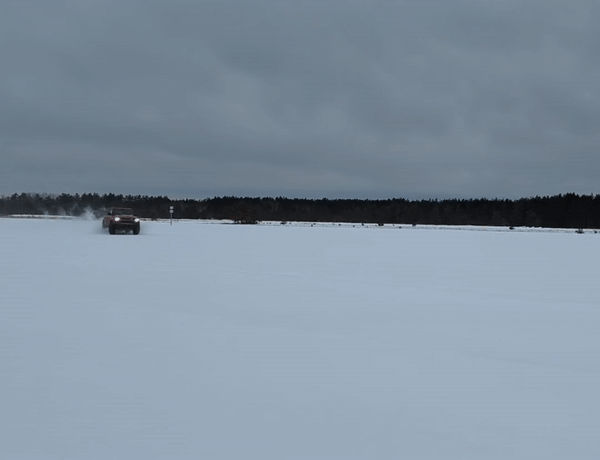
With that all-new 2021+ Ford Bronco finally getting into the hands of owners, most everyone is anxious to take it out, and see what it can do –– not to mention show if off a little. What better time than in the winter and snow!
The Bronco Nation took a road trip up to the Upper Peninsula of Michigan in December. We had exclusive access to a winter test facility, used for vehicle development by various companies. Special thanks goes out to our friends Bjorn, Chris, and Michael. We spent a few days there, then ventured off to explore the trails and backcountry of Drummond Island.
Bronco owners are, without question, more experienced in various driving situations and surfaces than most vehicle owners. One can see from the forums of what people are doing with their new Broncos already! Like any group, though, experience levels and skills vary. It is always good to go over some basic skills and driving tips, especially as we all “re-tune” our own driving skills every winter as the snow starts to fall. For some of you, it may be your very first winter experience with snow. With various types of winter driving conditions (icy/slippery roads, a few inches of snow, deep snow), and where one is driving (public roads, curvy roads, through a neighborhood, highways, or pure off-roading) one might ask, “How do I best drive in this and what G.O.A.T. mode should I be in?”
We’ll cover these basic driving skills that should help not only in snow, but in all driving conditions. And for those who are “tech savvy” and want to know how things work, and what you can do to make it an even more exciting, off-road experience, we’ll cover that also.
The Basics of Smart Driving
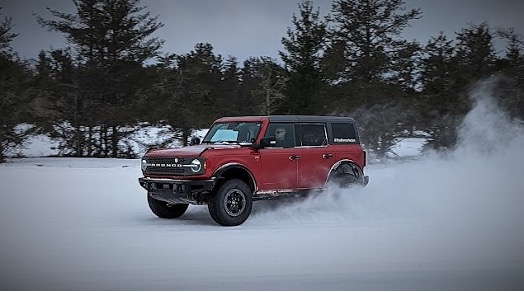 Let’s start off with some basics of how you can make yourself a better driver. Since the new Ford Bronco can’t do everything for you (not yet at least), what separates an expert driver from a novice driver in not only extreme weather conditions but also on the race track or in everyday driving?
Let’s start off with some basics of how you can make yourself a better driver. Since the new Ford Bronco can’t do everything for you (not yet at least), what separates an expert driver from a novice driver in not only extreme weather conditions but also on the race track or in everyday driving?
- Focus. Being focused on the road and your surroundings. The eyes are always moving: left-right, long distance, short distances in front of you. Continuously. In extreme weather driving conditions or off-roading, phones need to be put aside, as does searching for that perfect song on the radio. No distractions!
- Anticipate and be alert. As your eyes are moving, look at the other vehicles around you. Remember, in severe road conditions you have to be just as alert on their driving and actions as well, and how you would react. Potential animals running across a field, or out of the woods and right in front of you, especially in the evening hours. Also, I can’t tell you how many times I have heard of a deer actually hitting a car, broadside. Anticipate “where I would go, if I have to swerve" and "how much run out room do I have?" What is the path of least consequences, i.e., avoiding trees, oncoming traffic, or by not turning sideways to a downward slope or embankment which could result in severe consequences?
- Seat position and holding the steering wheel. Position your seat such that when your arms are fully extended, your wrists touch the steering wheel at the 3- and 9-o’clock positions. This is also where your hands should be. Hands over the wheel, fingers underneath, thumbs positioned near the top but on the inside of the wheel. It is a comfortable position that gives you a slight bend in your elbows, and is ideal for quick steering inputs when needed. Also, if in an accident, and the airbag deploys, this position allows your hands and arms to come back toward your shoulders and not to your face.
- “Smooth” steering, braking, and throttle movement is essential. This is what separates a great or even a professional driver from a novice driver. It is covered over and over again in various advanced driving schools. Controlled, smooth inputs on the throttle and brake pedals, and steering wheel. Never be abrupt.
How Technologies in All New Vehicles Makes Driving Safer
Technologies in today’s vehicles help the "novice driver” by smoothing out and aiding with steering, braking, and throttle response. They are highly tuned powertrain and brake systems that work seamlessly together. The abundance of sensors and modules, and their continual communication with each other, essentially makes today’s vehicles “semi-autonomous” compared to cars of yesteryear. Steering wheel angle, wheel speed sensors, YAW (lateral and rotational) sensors, throttle position, brake pressure, various shafts speeds, and temperature sensors are just a few. The modules are continually computing reactions to these various sensor inputs, then working together to send commands to the various components, for optimal response and safe performance.
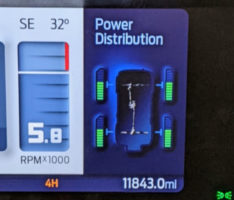 The powertrain system first manages torque and throttle response based on driver inputs, and the driveline system puts the torque to the appropriate wheels. In a clutch-based AWD system, this is further enhanced, with a controls system that is constantly changing torque split between the primary and secondary axles based on various sensor inputs related to driving conditions. The brake system can also send torque left-right across the axles, to the side with traction, with left-right brake traction control. Slight brake pressure is applied to the slippery side, which in essence fools the system to believe it is reacting torque to a higher frictional surface. Then an equal amount of torque can now be applied to the other side with traction. It’s certainly not as effective as a locker axle, but it can help with traction in slippery or less grip situations.
The powertrain system first manages torque and throttle response based on driver inputs, and the driveline system puts the torque to the appropriate wheels. In a clutch-based AWD system, this is further enhanced, with a controls system that is constantly changing torque split between the primary and secondary axles based on various sensor inputs related to driving conditions. The brake system can also send torque left-right across the axles, to the side with traction, with left-right brake traction control. Slight brake pressure is applied to the slippery side, which in essence fools the system to believe it is reacting torque to a higher frictional surface. Then an equal amount of torque can now be applied to the other side with traction. It’s certainly not as effective as a locker axle, but it can help with traction in slippery or less grip situations.
If things get out of control in adverse slippery conditions, then the brake system is the safety net, and starts to take charge. For example, you are on a slippery surface and you start to make a turn to follow the curved road to the left. Suddenly the vehicle feels like it is "understeering" –– or continuing to go straight –– due to the slippery surface. Panic, on your part, may start to set in. However, the sensors will see that the steering wheel is turned slightly left. The other vehicle sensors are also monitoring, and the modules will calculate that the vehicle is inadvertently tracking straight, due to a Low Mu surface (engineering talk for coefficient of friction between two bodies and pressing them together: in this case, the tires and the road surface you are on). The brake system will partially engage the inside brake and send a torque request to the engine to reduce torque, no matter what you are attempting to do with the throttle and brake pedals, as a result. If equipped with AWD, more torque may be sent to the rear axle, to also aid in rotating the vehicle properly, to track the desired steering wheel angle: thus, a “semi-autonomous” driving situation, where the vehicle is helping the driver to control the vehicle in the way in which they desire.
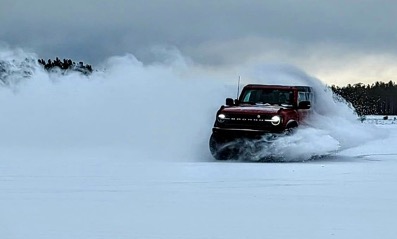 As a result of these safety features, one may think they are a better driver than they actually are. I remember being in a vehicle with a colleague. They owned both a F-150 Raptor and a Mustang GT, and talked about all of their track and off-road experience. We were driving on a mile-long, 250-foot-wide snow-covered lane. I put the vehicle into an off-road state, opening up the stability control brake system, with now minimal brake module intervention. Thus they were now driving “old school," just them being one with the vehicle. I had them do large S-turns at 25 MPH down the straightaway to see how they would respond to the snow-covered conditions. This is where you need to know how to “counter steer,” or to turn the steering wheel in the direction that the back of the vehicle is rotating out. After just a few turns they spun out into the snow bank. They were pretty surprised and thought that they were a much better driver than that. I then turned the brake stability control system back on. They ran the maneuver over again, and perfectly drove the length of the course, making precise S-turns.
As a result of these safety features, one may think they are a better driver than they actually are. I remember being in a vehicle with a colleague. They owned both a F-150 Raptor and a Mustang GT, and talked about all of their track and off-road experience. We were driving on a mile-long, 250-foot-wide snow-covered lane. I put the vehicle into an off-road state, opening up the stability control brake system, with now minimal brake module intervention. Thus they were now driving “old school," just them being one with the vehicle. I had them do large S-turns at 25 MPH down the straightaway to see how they would respond to the snow-covered conditions. This is where you need to know how to “counter steer,” or to turn the steering wheel in the direction that the back of the vehicle is rotating out. After just a few turns they spun out into the snow bank. They were pretty surprised and thought that they were a much better driver than that. I then turned the brake stability control system back on. They ran the maneuver over again, and perfectly drove the length of the course, making precise S-turns.
Vehicles Without G.O.A.T. Modes
As cars and trucks evolved over the years, we saw the additions of power steering/power brakes, Anti-lock Brakes, and Overdrive Cancel, Tow Haul, and Sport Mode switches. Traction control and stability control brake systems, advanced electronic powertrains with numerous features, Electric Power Assisted Steering, and adaptive suspensions have also been added or have evolved. These technologies have added safety, driving comfort, and driving excitement, amongst other things.
Vehicles without driving modes are tuned to be first and foremost safe, provide optimal fuel economy and emission compliance, and to provide added performance when needed –– a “one size fits all” powertrain and brake tuning, for all driving conditions. In some cases, where a Sport Mode or Tow Haul Button is available, enhancements are made in those Modes.
However, this “one size fits all” singular drive mode is like an all-season tire. There are many variants of an all-season tire as we know. Some are slightly better at driving and braking on pavement; others are better on slippery, Low Mu surfaces. In Europe, and in the Canadian providence of Ottawa, drivers are required by law to have winter tires in the winter and summer tires in the summer. Those tires are tuned specifically for those conditions, with rubber hardness, contact patch, and tread design as the varying factors. European drivers, in general, have always been very passionate drivers. That, coupled with curvy and hilly roads and Germany's Autobahn highway system, means they want tires that are specifically designed for the driving surfaces and conditions.
Thus, adding a multitude of driving modes, like G.O.A.T. Modes, allows for the fine-tuning of the various components and interfaces to now be optimal for those specific driving modes or surfaces.
G.O.A.T. Modes and How They Help in Snow
 What are G.O.A.T. Modes and how do they work? First off, G.O.A.T. modes are nothing new in the automotive industry. They have been around for years. They have been called Terrain Management Systems or TMS, Selectable Drive Modes or SDMs, and many other names. They essentially allow engineers to fine-tune the various systems (engine, transmission, driveline, and brakes). Bronco tends to have more of the Modes when fully equipped, as the vehicles are off-road capable, with more features like locking axles.
What are G.O.A.T. Modes and how do they work? First off, G.O.A.T. modes are nothing new in the automotive industry. They have been around for years. They have been called Terrain Management Systems or TMS, Selectable Drive Modes or SDMs, and many other names. They essentially allow engineers to fine-tune the various systems (engine, transmission, driveline, and brakes). Bronco tends to have more of the Modes when fully equipped, as the vehicles are off-road capable, with more features like locking axles.
What G.O.A.T. Mode to Use in Snow or Slippery Road Conditions
Slippery Mode
Slippery Mode should definitely be used when driving “on-road” when it is snowing, sleeting, raining, or icy conditions. Throttle response is slightly reduced, and engine torque at a given throttle position is also slightly reduced. The transmission is upshifting to higher gears (thus less torque to the wheels), and it takes more pedal movement to get a downshift. The AdvanceTrac brake system sensitivity is also increased for added safety intervention, applying individual brakes (that noise you hear when turning on slippery surfaces) and cutting out some of the powertrain torque when necessary. This aids in getting the vehicle back to its desired or intended path or direction. Remember the discussion above, about “what makes a novice driver more like an expert driver?” Smooth throttle, steering, and braking. This is what the vehicle is now helping you to achieve. In a sense, the system is dampening and controlling driver inputs, thus keeping the vehicle in control during white-knuckled situations, where stress levels can be high.
In deeper snow, one can turn off Traction Control, which is there to limit wheel slip and help to control the vehicle, especially in slippery conditions. During Normal operation, with Traction Control working, the brake system also can send a “reduced torque request” to the engine controller to prevent the tires from spinning. In many situations this is desired, for added stability control. In deep snow, over six inches, you want to keep momentum going, just like in mud or sand. Turning off Traction Control will now not suppress engine torque, which Traction Control does to aid in preventing wheel slip. The tires will break away and spin, as throttle increases. This added torque to the wheels and slight wheel spin (don’t over-stab the pedal, as to not bury yourself in) can help to get you through the deep snow. Also, if you do get stuck and want to “rock yourself out,” turning off Traction Control will help with that as well, as engine torque will not be reduced.

Mud/Rut and Sand Modes
These are both great Modes to use when off-roading in snow, and when the snow gets really deep. These Modes open up –– without fully disabling –– the added safety constraints put forth in Normal, Eco, and Slippery Modes. 4H will also be engaged in base ESOF T-case, 4A with EMTC T-Case, and if available, the rear locker will come on. Note: You have the option to change these default states. In a nutshell, more torque to the wheels based on pedal travel, holding lower transmission gears, and quicker throttle response, more tire spin, and less brake stability control. Be aware though, if driving through that deep snow-covered curvy street in your neighborhood, with slightly less brake stability control, you may encounter the back end of your vehicle coming out a little more around turns. If a parked car is on the street, be careful and drive cautiously.

And finally, for those who are out in the open field off-roading who want to go totally “old school" (some may call it “Donut Mode”), there is the “push and hold feature” of the Traction Control button. Depress the Traction Control switch and hold it for ~5 seconds. You will first see the “Hold for AdvanceTrac Off” message pop up on the cluster. Then you will see the “AdvanceTrac Off message (both below). This takes the “no boundaries” level up another notch and is recommended for off-road driving only, in Mud/Rut or Sand Modes. Lots of torque, lots of RPM, lots of wheel/tire slip, reduced brake intervention, thus more YAW or rotation. Be cautious at first, get used to it, have lots of wide open space, and adjust to your driving skills! As mentioned above, you will not have as much help of the vehicle to keep it in control. Also, “AdvanceTrac OFF” happens automatically when the T-case is placed into 4L. Note also that both Traction Control and AdvanceTrac will turn back on after a key cycle, or if you cycle again through the various G.O.A.T. modes.
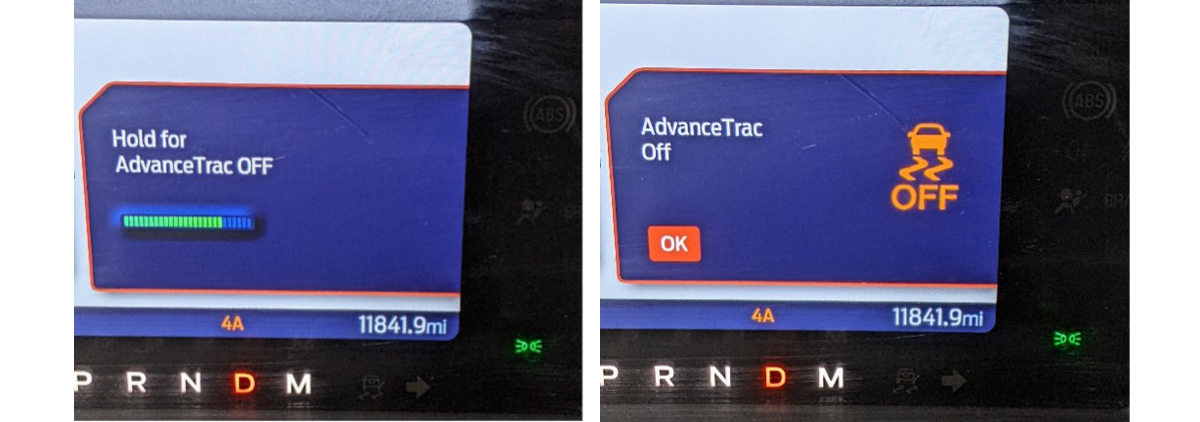
So that’s it, Bronco Nation family. Hopefully you are now equipped with a better understanding of your new Bronco in winter driving, along with a few tips on how you can make yourself a better driver with more confidence, and how the various systems work and interact, including which G.O.A.T. modes to use in winter driving, and why.
Slippery Mode is great for general on-road winter driving. It’ll keep you safe and in control of where you want to go, when the roads are slippery and your knuckles are white. When the snow gets deep, or you are off-roading, use Sand or Mud/Rut. It’ll give you more of that “old school” off-road freedom. And for extreme driving where YOU want even MORE off-road control and less vehicle intervention, turn off Traction Control, and push and hold the Traction Control button for the most autonomy.
I hope both the novice and experienced driver found this somewhat useful and maybe even learned something new. I will leave you with this: Ford engineers came together and created the new Bronco for you to have new adventures, experiences, and to create memories like you have never had before. Now go make some!
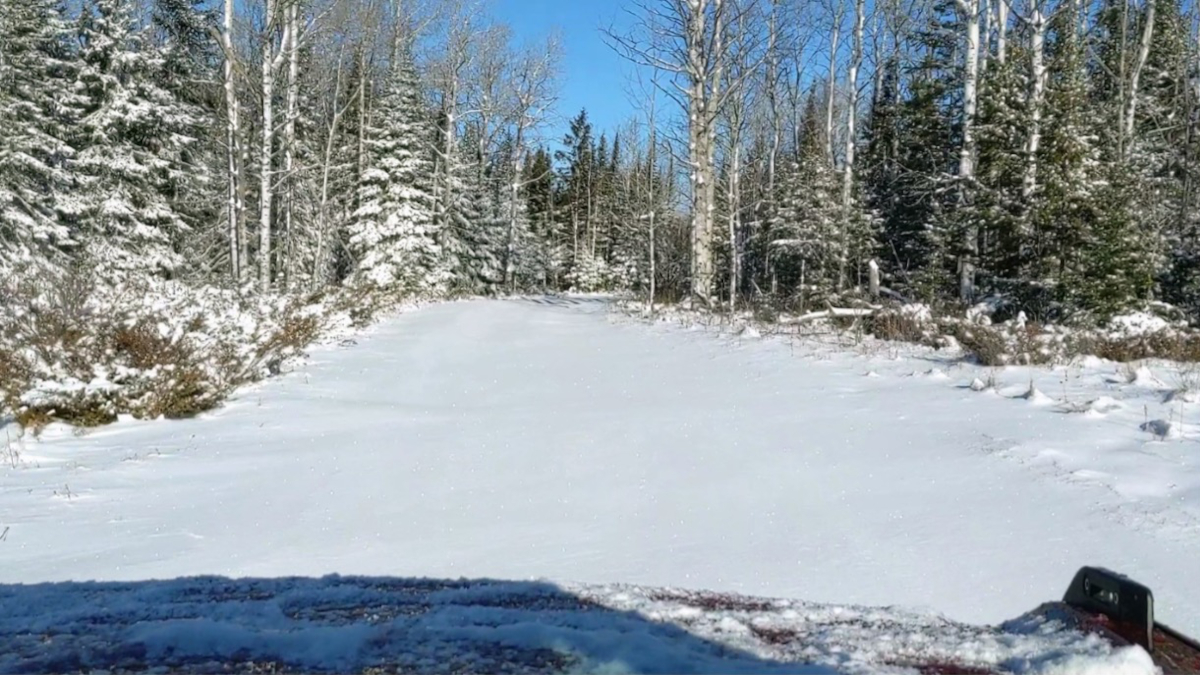
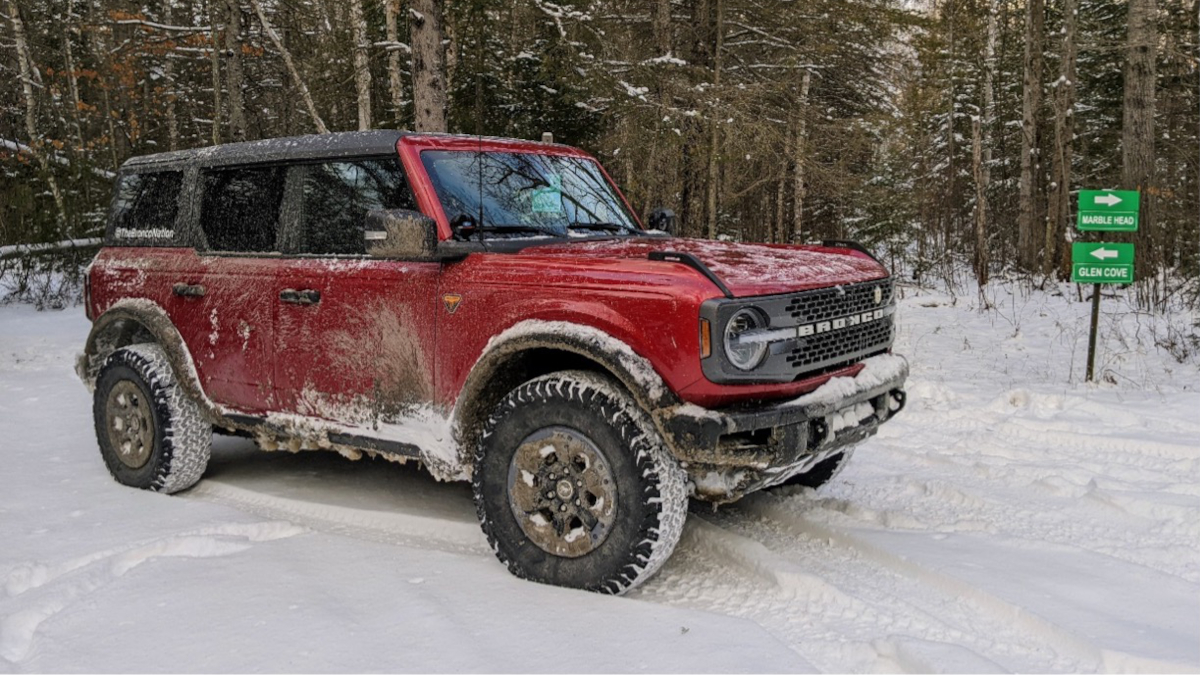

Comments
You must log in or register to post here.